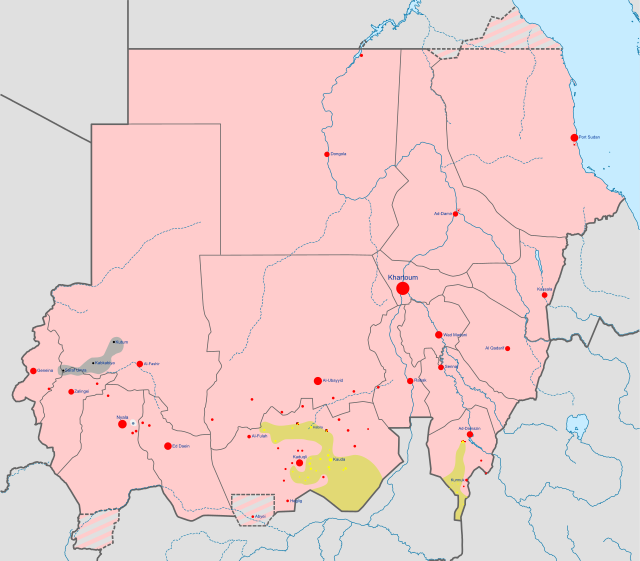War in Darfur: Difference between revisions - Wikipedia
 Article Images
Article Images
Content deleted Content added
m |
|||
Line 50: |} ==Background== {{main|History of Darfur}} The conflict taking place in Darfur has many interwoven causes. While rooted in structural inequality between the center of the country around the [[Nile]] and the 'peripheral' areas such as Darfur, tensions were exacerbated in the last two decades of the twentieth century by a combination of environmental calamity, non-sustainable fast [[population growth]], [[desertification]], political opportunism and regional politics<ref>{{cite book|title=Collapse|author=Diamond, Jared|isbn=0143036556|publisher=Penguin|year=2005}}</ref>. On [[June 16]], [[2007]], [[UN]] Secretary General [[Ban Ki-moon]] released a statement in which he proposed that the [[slaughter]] in Darfur was caused "at least in part from [[climate change]]", and that it "derives, to some degree, from man-made [[global warming]]".<ref>{{cite news|author=Ban Ki-moon|title=A Climate Culprit In Darfur|url=http://www.washingtonpost.com/wp-dyn/content/article/2007/06/15/AR2007061501857.html| date = [[2007-06-16]]| publisher = [[Washington Post]]|accessdate = 2007-06-23}}</ref> "''The scale of historical climate change, as recorded in Northern [[Darfur]], is almost unprecedented: the reduction in rainfall has turned millions of hectares of already marginal semi-desert grazing land into desert. The impact of climate change is considered to be directly related to the conflict in the region, as desertification has added significantly to the stress on the livelihoods of pastoralist societies, forcing them to move south to find pasture,''" the [[UNEP]] report states.<ref>[http://www.irinnews.org/Report.aspx?ReportId=72985 Climate change - only one cause among many for Darfur conflict]</ref> A point of particular confusion has been the characterization of the conflict as one between '[[Arab]]' and '[[African]]' populations, a [[dichotomy]] that one historian describes as "both true and false".<ref>[[Gérard Prunier]], ''Darfur: The Ambiguous Genocide'', Cornell University Press, 2005, ISBN 0-8014-4450-0, p. 4</ref><ref>{{cite news |title=Africa's Darfur |url=http://www.sundaypaper.com/CurrentArticles/tabid/98/articleType/ArticleView/articleId/407/072907-LEFTRIGHT-Africas-Darfur.aspx |date=[[2007-07-29]] |publisher=[[The Sunday Paper]] |accessdate=2007-09-26}}</ref> In the late fourteenth or early fifteenth century, the [[Keira dynasty]] of the [[Fur people]] of the [[Marrah Mountains]] established a [[sultan]]ate with [[Islam]] as the [[state religion]]. The sultanate was conquered by the [[Turkiyah|Turco-Egyptian]] force expanding south along the Nile, which was in turn defeated by the [[Muhammad Ahmad]], the self-proclaimed ''[[Mahdi]]''. The Mahdist state collapsed under the onslaught of the British force led by [[Herbert Kitchener, 1st Earl Kitchener|Herbert Kitchener]], who established an [[History of the Anglo-Egyptian co-dominium|Anglo-Egyptian co-dominium]] to rule Sudan. The British allowed Darfur ''[[de jure]]'' autonomy until 1916 when they invaded and incorporated the region into Sudan.<ref>Prunier, pp. 8-24</ref> Within Anglo-Egyptian Sudan, the bulk of resources were devoted toward [[Khartoum]] and [[Blue Nile Province]], leaving the rest of the country relatively undeveloped. [[Image:Darfur IDPs 1 camp.jpg|thumb|An [[internally displaced persons]] camp in [[Darfur]]]] The inhabitants of the Nile Valley, which had received the bulk of British investment, continued the pattern of economic and political marginalization after independence was achieved in 1956. In the 1968 elections, factionalism within the ruling [[Umma Party (Sudan)|Umma Party]] led candidates, notably [[Sadiq al-Mahdi]], to try to split off portions of the Darfuri electorate either by blaming the region's underdevelopment on the Arabs, in the case of appeals to the stationary peoples, or by appealing to the Baggara semi-nomads to support their fellow Nile Arabs. This Arab-African dichotomy, which was not an indigenously developed way of perceiving local relations, was exacerbated after [[Libya]]n President [[Muammar Gaddafi]] became focused on establishing an Arab belt across the [[Sahel]] and promulgated an ideology of Arab supremacy.<ref>Prunier, pp. 42-44</ref> As a result of a sequence of interactions between Sudan, Libya and [[Chad]] from the late 1960s through the 1980s, including the creation of the Libyan-supported [[Islamic Legion]], Sudanese President [[Gaafar Nimeiry]] established Darfur as a rear base for the rebel force led by [[Hissène Habré]], which was attempting to overthrow the Chadian government and was also anti-Gaddafi.<ref>Prunier, pp. 44-47</ref> In 1983 and 1984, the rains failed and the region was plunged into a [[famine]].<ref>Prunier, pp. 47-52</ref> The famine killed an estimated 95,000 people out of a population of 3.1 million. Nimeiry was overthrown on [[5 April]] [[1985]], and Sadiq al-Mahdi came out of exile, making a deal with Gaddafi, which al-Mahdi did not honor, to turn over Darfur to Libya if he was supplied with the funds to win the upcoming elections.<ref>Prunier, pp. 52-53, 56</ref> In early [[2003]], two local rebel groups — the [[Justice and Equality Movement]] (JEM) and the [[Sudan Liberation Movement]] (SLM)<ref name=SLM-POLITICAL-DECLARATION>{{cite web |title=The Sudan Liberation Movement and Sudan Liberation Army (SLM/SLA) Political Declaration |url=http://www.sudan.net/news/press/postedr/214.shtml |date=[[2003-03-14]] |publisher=[[Sudan Liberation Movement]] |accessdate=2007-02-07 }}</ref> — accused the government of oppressing non-Arabs. The SLM, which is much larger than the JEM, is generally associated with the Fur and Masalit, as well as the Wagi clan of the Zaghawa, while the JEM is associated with the Kobe clan of Zaghawa. Later that year, leaders of both groups, the Sudanese Government and representatives of the International diplomatic community were brought together in Geneva by the [[Center for Humanitarian Dialogue]] to look at ways of addressing the humanitarian crisis. In 2004, the JEM joined the [[Eastern Front (Sudan)|Eastern Front]], a group set up in 2004 as an alliance between two eastern tribal rebel groups, the [[Rashaida]] tribe's [[Free Lions]] and the [[Beja Congress]]. The JEM has also been accused of being controlled by [[Hassan al-Turabi]]. On [[January 20]], [[2006]], SLM declared a merger with the Justice and Equality Movement to form the Alliance of Revolutionary Forces of West Sudan. However, in May of that year, the SLM and JEM were again negotiating as separate entities. ==History of the conflict, 2003-2007== | |||